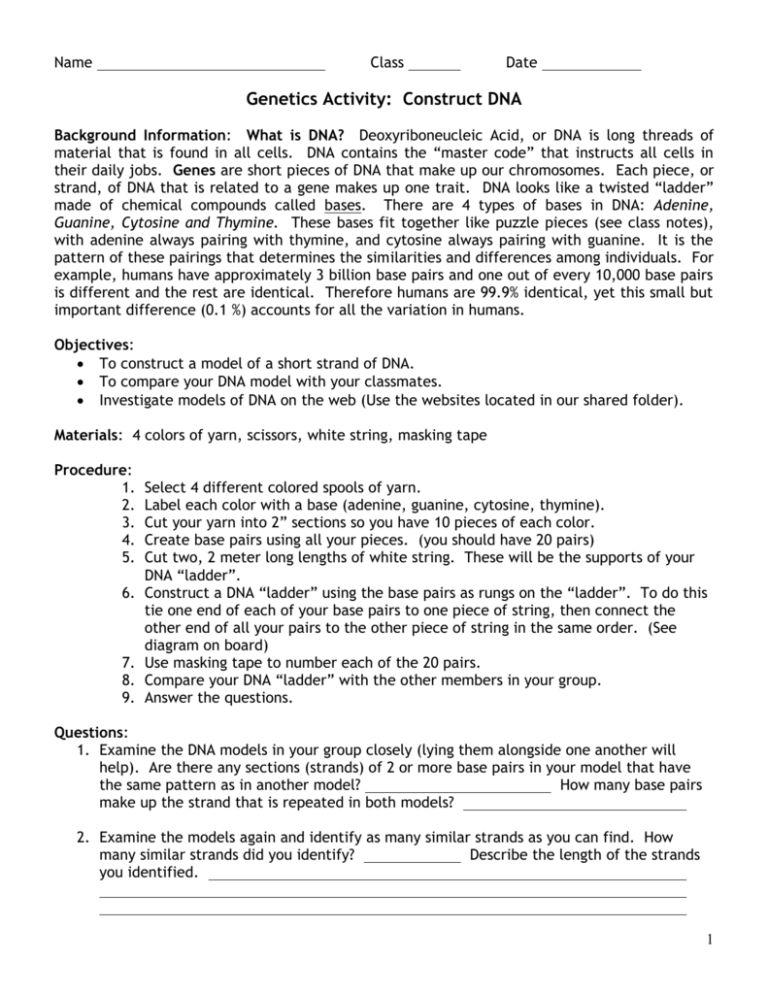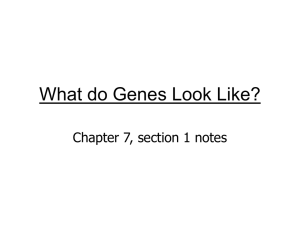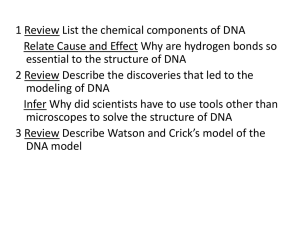Construct DNA Activity
advertisement

Name Class Date Genetics Activity: Construct DNA Background Information: What is DNA? Deoxyriboneucleic Acid, or DNA is long threads of material that is found in all cells. DNA contains the “master code” that instructs all cells in their daily jobs. Genes are short pieces of DNA that make up our chromosomes. Each piece, or strand, of DNA that is related to a gene makes up one trait. DNA looks like a twisted “ladder” made of chemical compounds called bases. There are 4 types of bases in DNA: Adenine, Guanine, Cytosine and Thymine. These bases fit together like puzzle pieces (see class notes), with adenine always pairing with thymine, and cytosine always pairing with guanine. It is the pattern of these pairings that determines the similarities and differences among individuals. For example, humans have approximately 3 billion base pairs and one out of every 10,000 base pairs is different and the rest are identical. Therefore humans are 99.9% identical, yet this small but important difference (0.1 %) accounts for all the variation in humans. Objectives: To construct a model of a short strand of DNA. To compare your DNA model with your classmates. Investigate models of DNA on the web (Use the websites located in our shared folder). Materials: 4 colors of yarn, scissors, white string, masking tape Procedure: 1. 2. 3. 4. 5. 6. 7. 8. 9. Select 4 different colored spools of yarn. Label each color with a base (adenine, guanine, cytosine, thymine). Cut your yarn into 2” sections so you have 10 pieces of each color. Create base pairs using all your pieces. (you should have 20 pairs) Cut two, 2 meter long lengths of white string. These will be the supports of your DNA “ladder”. Construct a DNA “ladder” using the base pairs as rungs on the “ladder”. To do this tie one end of each of your base pairs to one piece of string, then connect the other end of all your pairs to the other piece of string in the same order. (See diagram on board) Use masking tape to number each of the 20 pairs. Compare your DNA “ladder” with the other members in your group. Answer the questions. Questions: 1. Examine the DNA models in your group closely (lying them alongside one another will help). Are there any sections (strands) of 2 or more base pairs in your model that have the same pattern as in another model? How many base pairs make up the strand that is repeated in both models? 2. Examine the models again and identify as many similar strands as you can find. How many similar strands did you identify? Describe the length of the strands you identified. 1 3. Now connect your model to your partner’s model (making a ladder with 40 pairs) and compare this larger model with another group. Did you find more or less shared strands than with the 20 pair models? 4. Now connect this 40 pair model with another groups model (making an 80 pair model) and compare to another group. Examine the models closely and describe (number and length) the shared strands that you identify. 5. Explain why there is such a possibility for the DNA models to have similarities. 6. Your model was constructed with 20 base pairs and then grew to 80 base pairs. Describe what happened, in terms of similarities with other models, as the models grew? Why do you think this happened? 7. Imagine a complete sample of human DNA with 3 billion base pairs. Compare the observations of your models with what we know about human DNA and explain why a difference of one base pair in 10,000 can result in all the variation witnessed in humans. 8. Finally, take your model and hold it up from the ends, then fold it as small as possible. Describe how it is possible for human DNA to be contained in every cell. 2





